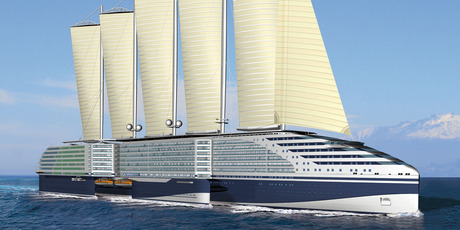Imagination seems the only limit for liners
By Grant Bradley
Cruise industry is putting emphasis on fuel-efficient designs for vessels.

Features of STX's environmentally friendly Eoseas project include huge sails to supplement
its LNG power plant. Photo / Supplied
The sky's the limit for cruise ships in the future.
"The market will decide what we're going to do. If the guests want to pay for it we can take the Voyager to the moon," said Voyager of the Seas captain Charles Teige.
The third-generation Norwegian mariner has been at sea for 30 years, and a cruise ship captain for Royal Caribbean International for the past decade.
Since the mid-1990s the size of ships has grown astronomically - the largest of his line is Allure of the Seas at 225,000 tonnes and the length of more than 3 rugby fields.
Teige said there were no restrictions on the length. On the drawing board are huge floating islands, with airports and lagoons, served by tenders.
Not quite cruise liners, these resorts for day or year-long stays could be towed to big international events such as the Olympic Games.
Other liners of the future such as STX's Eoseas project has huge sails to supplement its LNG power plant and would be covered in solar panels to provide more energy, and some are semi-submersible.
A third lane in the Panama Canal will allow even bigger ships to use the critical shortcut when it opens in 2014.
Teige said the cruise industry planned on ships having lives of about 20 years, so designers had to get the vessels right. The biggest can cost close to $2 billion to build.
Ship design is built partly on feedback from passengers, who are comprehensively surveyed before disembarking.
Gavin Smith, chief executive of Royal Caribbean Cruises in Australia and New Zealand, said it was also based on the work of specialists in modelling what spaces could work in the future. "We engage with futurists who are predictors of behaviour that Governments might use when they're building infrastructure."
The cruise industry started in the Caribbean and although most ships have been built to suit those conditions, they are becoming more adaptable to suit other markets.
Teige said this flexibility would be a feature of new ships. There would be more retractable roofs over pools and outdoor areas to ensure they're suited to colder conditions.
Different markets demanded different facilities. In Asia onboard shopping and casinos were popular whereas New Zealanders and Australians wanted good food and drink, and spent a lot of time on deck.
"We have to have ships that are flexible in different areas with venues that can be used for different activities," Teige said.
Demand for more specialised dining is likely to grow. Ships will have even more smaller, distinct and intimate spaces.
The passenger make-up is changing - they're getting younger (30-40 years old in the United States and 50 in this region) and there are more parties of three generations, with grandparents, parents and children.
Although the Voyager of the Seas was a mass-market vessel, Teige said, 27 architects designed the interior to ensure the look was not uniform.
"The vacation industry changes very quickly. It's like building a new car. What's popular five years ago isn't going to be popular in the future."
The cruise industry faces tighter environmental restrictions and is already putting emphasis on more fuel-efficient designs.
This ranges from more efficient bow bulbs to new anti fouling technology and simply grinding off weld seams to make ships more sleek.
Tight restrictions are coming in for emissions in 2015, with cleaner burning diesel required in European and North American ports and more cruise ships using scrubbers to clean up sulfur and harmful particulates from heavy fuel exhaust.
Teige said the Voyager of the Seas had a full-time environmental officer on board whose role was to ensure all requirements within different jurisdictions were met.
Most cruise ships are built in European shipyards in Norway, Finland, France, Germany and Italy. Fitting out the ships is a multinational effort, with furniture from all around Europe.
Voyager of the Seas' diesel electric motors generate 104,000 horse power and it is capable of 40 knots.
Teige said ships were easy enough to drive "when you know what you're doing" but the room for mistakes was getting tighter.
"The ships are getting bigger but the ports are the same - the margins are smaller, there's not much room for error."
Not only is the size of ships growing but so is the range of destinations.
Flight Centre subsidiary Cruiseabout said although Australia and the South Pacific made up more than 50 per cent of cruises booked by New Zealanders other destinations were growing quickly.
Cruiseabout brand leader Jessica Allan said the popularity of cruises to European waterways, Alaska and Antarctica was likely to keep growing in the next few years.
She said Kiwis were embracing the fly and cruise options that are becoming increasingly available to a wide range of destinations.
River cruising in Europe was extremely popular for several reasons, including smaller ship size and the minimal chance of seasickness.
Asia was becoming increasingly popular with experienced cruisers as they looked to experience the destination in a softer and safer environment than they might if they were travelling there alone.
Source: The New Zealand Herald.
No comments:
Post a Comment